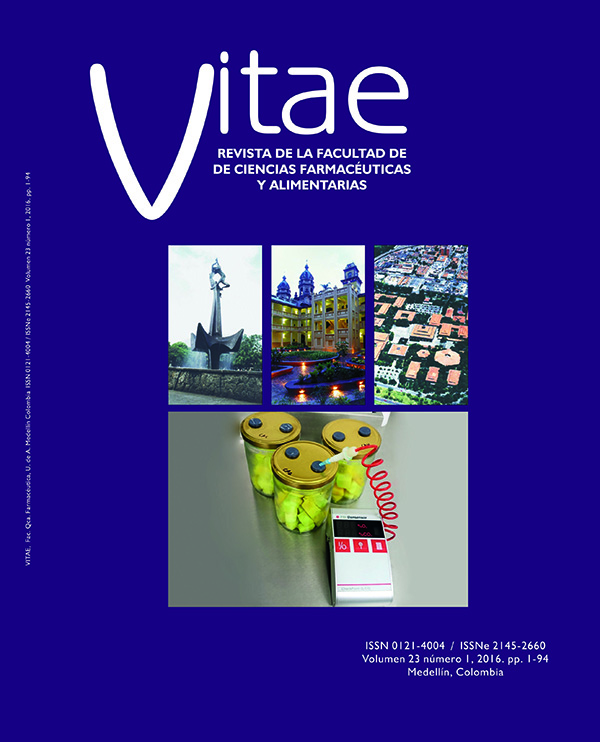VARIATION IN MINERALS CONTENT IN FRUITS OF PEPPER (CAPSICUM ANNUUM L.) LANDRACES, GROWN IN GREENHOUSE
DOI:
https://doi.org/10.17533/udea.vitae.v23n1a05Keywords:
Capsicum, macrominerals, trace elements, atomic spectrophotometry, nutritional quality.Abstract
Background: Malnutrition is a major health problem in developed and developing countries, and in Latino American, a viable option is reconsider the pre-Columbian and traditional diets based on endemic species. In Mesoamerica, the chilli or pepper (Capsicum annuum L.) played an important role, and its contribution remain until today in the Mexican gastronomy. Objective: the aim of the present work was to evaluate the variation among and within five morphotypes of pepper (C. annuum L.) native of Oaxaca, Mexico, in relation to minerals content in fruits. Methods: a collection of 45 population samples of chilli pepper, which were grouped in five morphotypes named as chile de Agua, Tabiche, Piquin, Solterito and Nanche, and later planted in greenhouse conditions under a complete blocks randomized design with three replications. At harvest time a fruit samples from 300 to 500 g per population were obtained, and later the samples were incinerated to obtain ashes, which were solubilized in acid medium. The determinations of Cu, Fe, Mg, Zn, Na, K, and Ca were done by atomic absorption spectrometry, and the S and P elements were quantified by an UV-vis spectrometer. Results: in the analysis of variance, significant differences (P < 0.05) were determined among and within morphotypes of C. annuum over all macro and trace elements. Solterito presented the highest values in eight mineral elements, after Piquin and chile de Agua were the second more important. In Fe content, Piquin and Solterito showed high values between 8.0 and 8.5 mg/100 g of dry sample weight. Into each morphotype, the outstanding populations were: CAG03 and CAG10 from chile de Agua; CNA02 of Nanche; CPI02 and CPI09 of Piquin type; CSO01, CSO02 and CSO03 from Solterito; and CTA02 and CTA05 from Tabiche type. The differences among morphotypes were confirmed in the multiple discriminant analysis and the Mahalanobis’ distances. Conclusions: The results showed differences among and within morfotypes of C. annuum, and the minerals content reported indicate that, the chilli pepper is a food with high nutritional values. In fact 100 g of dry weight, potentially can supply the dairy needs of Cu, Mg, P and an important proportion of the needs of Fe, Zn and K, among other nutritional elements.Downloads
References
Brown CH, Clement CR, Epps P, Luedeling E, Wichmann S. 2013. The paleobiolinguiscs of domesticated chili pepper (Capsicum spp.). Ethnoliology Letters. 2013 Jan; 4:1-11.
Long J. Los senderos prehispánicos del Capsicum. In: Long J, León A (coords.), Caminos y Mercados de México. Serie Histórica General 23, UNAM e INAH. México, D.F. 2010, pp: 79-105.
Castellón-Martínez E, Chávez-Servia JL, Carrillo-Rodríguez JC, Vera-Guzmán AM. Preferencias de consumo de chiles (Capsicum annuum L.) nativos en los Valles Centrales de Oaxaca. Rev Fitotec Mex. 2012 Sep.; 35(Núm. Esp. 5): 27-35.
Sistema de Información Agroalimentaria y Pesquera (SIAP). 2014. Anuario Estadístico de la Producción Agrícola 2013 en México. Sistema de Información Agroalimentaria y Pesquera de la Secretaría de Agricultura, Ganadería, Desarrollo Rural, Pesca y Alimentación. México, D.F. 2014 [citado junio 2015]. Disponible
Flores P, Hellín P, Lacasa A, López A, Fenoll J. Pepper mineral composition and sensory attributes as affected by agricultural management. J Sci Food Agr. 2009 Nov.; 89(14): 2364-2371.
Kraft KH, Luna-Ruiz JJ, Gepts P. Different seed selection and conservation practices for fresh market and dried chile farmers in Aguascalientes, Mexico. Econ Bot. 2010 Dec.; 64(4): 319-328.
Vera-Guzmán AM, Chávez-Servia JL, Carrillo-Rodríguez JC, López MG. Phytochemical evaluation of wild and cultivated pepper (Capsicum annuum L. and C. pubescens Ruiz & Pav.) from Oaxaca, Mexico. Chilean J. Agric Res. 2011 Oct.-Dec.; 71(4): 578-585.
Ghasemnezhad M, Sherafati M, Payvast GA. Variation in phenolic compound, ascorbic acid and antioxidant activity of five coloured bell pepper (Capsicum annum) fruits at two different harvest times. J Funct Foods. 2011 Jan.; 3:44-49.
Rao BN. Bioactive phytochemicals in Indian foods and their potential in health promotion and disease prevention. Asia pacific J Clin Nutr. 2003 Mar.; 12(1): 9-22.
Clark R and Le S-H. Anticancer properties of capsaicin against human cancer. Anticancer Res. 2016 Feb.; 36(2): 837-844.
Cázares-Sánchez E, Ramírez-Vallejo P, Castillo-González F, Soto-Hernández M, Rodríguez-González T, Chávez-Servia JL. Capsaicinoides y preferencia de uso en diferentes morfotipos de chile (Capsicum annuum L.) del centro-oriente de Yucatán. Agrociencia. 2005 Nov.-Dic.; 39(6): 627-638.
Morán-Bañuelos SH, Aguilar-Rincón VH, Corona-Torres T, Castillo-González F, Soto-Hernández RM, San-Miguel-Chávez R. Capsaicinoides en chiles nativos de Puebla, México. Agrociencia. 2008 Oct.-Nov.; 42(7): 807-816.
Fraga CG. Relevance, essentiality and toxicity of trace elements in human health. Mol Aspects Med. 2005; 26: 235-244.
World Health Organization (WHO). Trace Elements in Human Nutrition and Health. World Health Organization, Belgium. 1996; 343 p.
Solomons NW, Kaufer-Horwitz M, Bermúdez OI. Armonización de las recomendaciones nutricionales para Mesoamérica: ¿unificación regional o individualización regional?. Arch Latin Nutr. 2004 Dic.; 54(4): 363-373
Statistical Analysis System (SAS). SAS® Procedures Guide, Version 8. SAS Institute Inc. Cary, NC, USA. 1999; 1643 p.
Rubio C, Hardisson A, Martín RE, Báez A, Martín MM, Álvarez R. Mineral composition of the red and green pepper (Capsicum annuum) from Tenerife Island. Eur Food Res Technol. 2002 Jun.; 214(6): 501-504.
Ogunlade I, Alebiosu AA, Osasona A. Priximate, mineral composition, antioxidant activity, and total phenolic content of some pepper varieties (Capsicum spp.). Int J Biol Chem. Sci. 2012 Oct.; 65(5): 2221-2227.
Ribes-Moya A, Pereira L, Guijarro-Real C, Raigon MD, Fita AM, Rodríguez-Burruezo A. Mineral content in Capsicum pepper landraces: effect of the genotype and the ripening stage. Bull UASVM Hort. 2014 ; 72(2): 2519-260
BenMansour-Gueddes S. Evolution of capsaicinoids and minerals composition during fruit development in some hot pepper varieties (Capsicum annuum L.). Int J Agric Innov Res. 2015; Jan-Feb; 3(4): 1094-1102.
Khadi BM, Goud JV, Patil VB. Variation in ascorbic acid and mineral content in fruits of some varieties of chilli (Capsicum annuum L.) Plant Foods Hum Nutr. 1987 Mar.; 37(1): 9-15.
López A, Fenoll J, Hellín P, Flores P. Physical characteristics and mineral composition of two pepper cultivars under organic, conventional and soilless cultivation. Sci Hortic-Amsterdam. 2013 Feb.; 150: 259-266.
Pérez-López JA, López-Nicolaz LM, Núñez-Delicado E, delAmor FM, Carbonell-Barrachina AA. Effects of agricultural practices on color, carotenoids composition, and mineral contents of sweet peppers, cv. Almuden. J Agric Food Chem. 2007 Oct.; 55(20):8158-8164.
Guil-Guerrero JL, Martínez-Guirado C, Rebolloso-Fuentes MM, Carrique-Pérez A. Nutrient composition and antioxidant activity of 10 peppers (Capsicum annuum) varieties. Eur Food Res Technol. 2006 Nov.; 224: 1-9.
Castellón-Martínez E, Carrillo-Rodríguez JC, Chávez-Servia JL, Vera-Guzmán AM. Variación fenotípica de morfotipos de chile (Capsicum annuum L.) nativo de Oaxaca, México. Phyton, Rev Int Bot Exp. 2014; 83: 225-236.
Association of Official Analytical Chemists (AOAC). Official methods of analysis of the Association of Official Analytical Chemists. Vol. 1, 15th ed. Association of Official Analytical Chemists, Washington DC, USA. 1990; p: 12-13, 27-28, 42, 330-331.
Lopez , Castillo C, Diazgranados D. El zinc en la salud humanaI. Rev Chil Nutr. 2010 Jun; 37(2): 234-239
Downloads
Published
How to Cite
Issue
Section
License
Copyright (c) 2016 Vitae

This work is licensed under a Creative Commons Attribution-NonCommercial-ShareAlike 4.0 International License.
Copyright Notice and Open Access Statement
The Journal Vitae works under the Open Access license, and the published manuscripts remain available for the public, both on the Journal's website and in databases, under the Creative Commons license, "Noncommercial Attribution" and "Share alike" systems, adopted in Colombia. Hence, when the authors agree to publish in the Journal Vitae, they will not have the right to economic retributions on publications and reproductions through different diffusion media. The documents are freely available to the internet public, permitting users to read, download, copy, distribute, print, search, or link to the full texts and pass them as data to software. The only constraint on reproduction and distribution, should be to give authors control over the integrity of their work and the right to be appropriately acknowledged and cited.
Authors declare that:
-
They are the intellectual property owners and are responsible for all the information stated in the article.
-
This manuscript has not been submitted or published in other printed or digital media. They accept the responsibility for the judgments, opinions, and points of view expressed in the published article and, therefore, they exonerate Universidad de Antioquia and Journal Vitae from any process.
-
They exempt Universidad de Antioquia and Journal Vitae from settling conflicts or disputes related to the authorship of the referred article.
-
They accept the revision of the original manuscript by suitable personnel, and they bind themselves to perform the corrections appointed or suggested by the assessors.
-
Therefore, they know the editorial process and will not bind the Editorial Board of the Journal to assume any obligations regarding the volume and issue in which the article is published.
-
They transfer the rights of publication, reprinting, and distribution of the article from the moment of its approval, in print and digital format, without the right to economic rewards, and under the licensing conditions considered relevant by Journal Vitae.
-
They fully authorize Universidad de Antioquia and Journal Vitae to submit the published material to the diverse databases and indexing systems where the Journal can be found to comply with the requirements of the regulatory authorities to maintain the national classification of journals.
-
They will assume the article publication costs established for the current issue, and they will make the payment as soon as they are informed about the volume and the issue in which the final version of the article is published.
-
After the article is published, you can share digital or printed copies in a noncommercial manner. You will be able to use the paper in your institution or company for educational or research purposes, including the use in course programs.
Conflict of interest: Authors are responsible for recognizing and disclosing any financial or other benefits that could be perceived to bias their work, acknowledging all financial support and any personal connections with potential sponsors. Examples of such conflicts include receiving research funds or honoraria, serving on advisory boards, stock ownership, or employment and consulting arrangements. Authors without such connections should clearly state that they have no financial support or personal relationships that could be perceived to bias their work. All conflicts of interest should be disclosed on the author's identification page of the manuscript.










